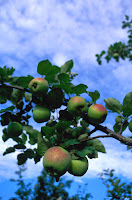I drew a picture of a pyramid on the board. "This is how we typically think of our organizational structures, with management at the narrow top. Now, where do you find pyramids?" It didn't take long for the group to respond with "desert". I continued, "And deserts are not usually very alive or thriving."
Now pyramids are strong and durable but they are eroded over time. They don't adapt well to winters, droughts, floods. They just stand there doing the same old thing year after year. There is no changing a pyramid.
I drew a picture of a fruit tree. "Here's another way to think of a live, dynamic and thriving organization. The fruit is being created by the people interacting with customers, suppliers, each other. Management is the support, the trunk, that feeds and nourishes the part of the organization that's creating the results."
When we look for change in the organization, we need them to be like fruit trees. If they are fruit trees, then management needs to be like the roots seeking out resources to feed the rest of the organization. They also need to be like strong supports that can prevent the rest of the group from crashing with every gust of wind.
Is your company more like a pyramid or a tree?


No comments:
Post a Comment